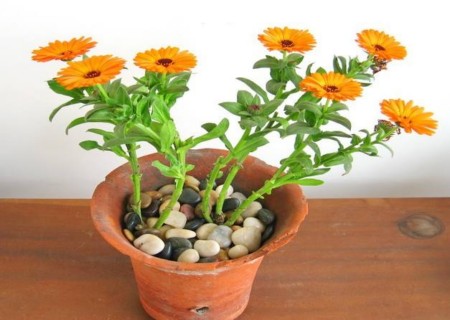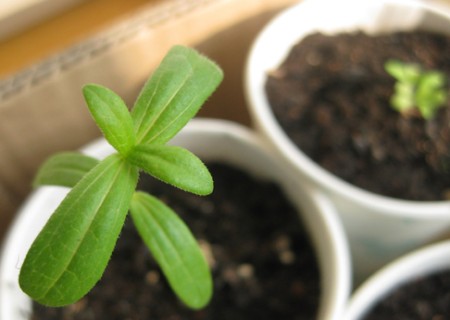Planting method of potted Calendula
Calendula, rich in mineral phosphorus and vitamin C, often eaten can relieve dysmenorrhea, anxiety and neurasthenia, but also can nourish the liver and clear eyes, etc., is very suitable for female friends to drink tea. Its flowers are full, giving a sunny feeling, and its leaves are spoon-shaped with some white whiskers. Calendula not only has high therapeutic value, but also has high ornamental value. It can not only make a wreath to decorate the environment, but also make potted plants for viewing.

Because the marigold blossoms for a long time, it is regarded as a symbol of "long-term" and is often used in weddings to decorate flowers. Calendula also symbolizes the noble feelings of a gentleman, so it is very popular. So, how to plant and cultivate potted marigold? The following editor will introduce to you the planting method of this beautiful plant.
1. Soil
As the marigold is very adaptable to the growing environment, and resistant to cold and barren, it is easy to grow. If it is in the loose, fertile, highly permeable sand, the growth state will be better. It is suggested that the soil PH value should be between 6 and 7, so that the plant has more branches and larger flowers.
2. Reproduction
The propagation method of calendula should be completed by sowing method and cutting method, but mainly by sowing method. The seeds are usually sowed from September to October in autumn, and the seeds need to be soaked and germinated before sowing.
3. Transplanting seedlings
When Calendula seeds take root and sprout, observe the germination of its leaves, and transplant seedlings when more than 3 leaves are grown.
4. Upper basin
After the first seedling transfer, in addition to careful maintenance, we should also pay attention to observe the growth of the plant. when the seedlings grow 6 or 7 leaves, we can plant them in the pot.
5. Pick the heart
After the plant has been planted for more than a week, in order to promote the seedlings to grow more branches, that is, to sprout more lateral branches and increase the number of flowers, we can treat them with coring. The head should be wiped immediately after the first batch of flowers to sprout more new branches and bloom again. Or it can be used to control the growth height of seedlings by spraying leaves more easily than for a long time.
6. Watering
Because marigold is a drought-tolerant plant, the requirement for water is not very high. During the seedling growing period, we can't pour too much water on it, just keep the soil a little moist all the time.
7. Fertilization
Organic fertilizer should be applied to the plant every two or three weeks, and human and animal urine is recommended until the end of February. It is only when there is an adequate supply of nutrients that progress will bloom large and many flowers. On the other hand, if there is a lack of nutrients, the flowers will bloom very small and last for a short time.
8. Florescence
When calendula blossoms for the first time, we can't take seeds, and we have to cut off the withered flowers after the flowers fade, which is more conducive to sprouting more branches, blooming more at a later stage, and prolonging the flowering period.
9. Keep the seed
In the previous step, we said that we could not leave seeds after the end of the first flowering, which did not mean that we should not leave seeds. Seed retention was carried out at a later stage. When keeping seeds, we should choose high-quality plants with big bright flowers and pure varieties. Moreover, seed collection should also be carried out in sunny days to prevent shedding.
Time: 2019-05-24 Click:
- Prev

Cultivation methods / steps of bonsai of Phyllanthus angustifolia
The branches of Phyllanthus angustifolia are smooth and clustered, and its newly germinated buds are reddish to red. It is a very beautiful garden application plant. Turning it into a landscape tree or modeling tree is bound to add a lot of beauty and vitality to the garden.
- Next

Hundred-day grass planting diary
As we all know, the suitable temperature for zinnia sprouting is between 20 and 25 ℃. Normally, it can sprout after a week of sowing. In order to verify this process, the editor pushed a hundred-day grass planting diary for you. Let's witness this process together.
Related
- Fuxing push coffee new agricultural production and marketing class: lack of small-scale processing plants
- Jujube rice field leisure farm deep ploughing Yilan for five years to create a space for organic food and play
- Nongyu Farm-A trial of organic papaya for brave women with advanced technology
- Four points for attention in the prevention and control of diseases and insect pests of edible fungi
- How to add nutrient solution to Edible Fungi
- Is there any good way to control edible fungus mites?
- Open Inoculation Technology of Edible Fungi
- Is there any clever way to use fertilizer for edible fungus in winter?
- What agents are used to kill the pathogens of edible fungi in the mushroom shed?
- Rapid drying of Edible Fungi

